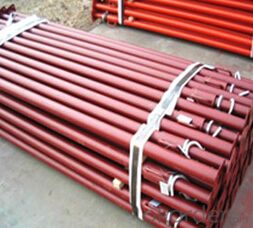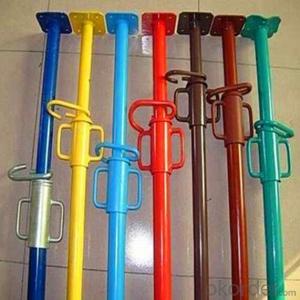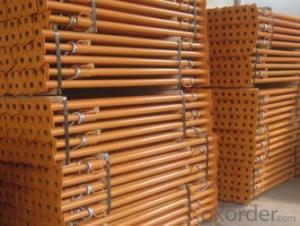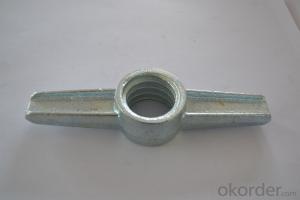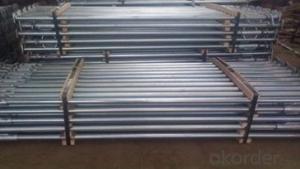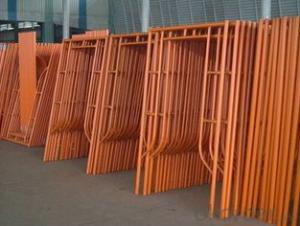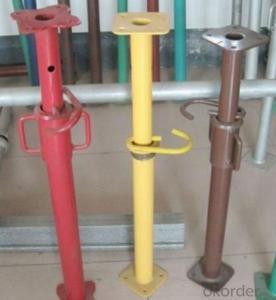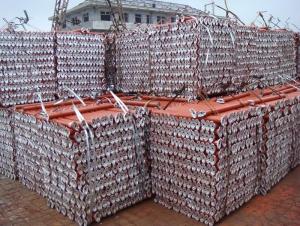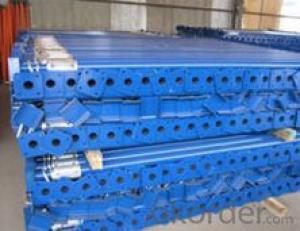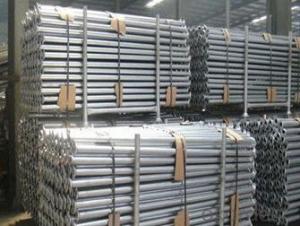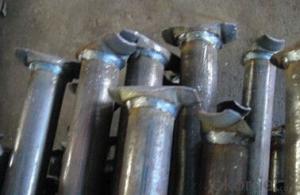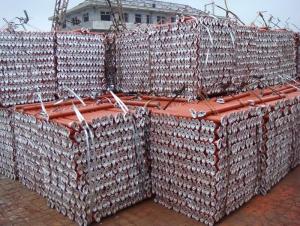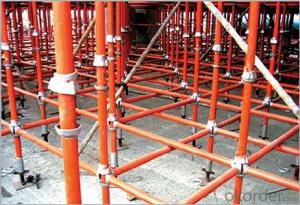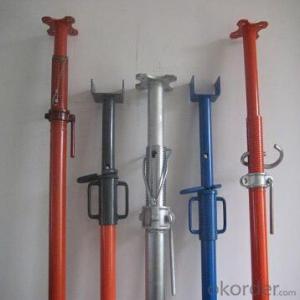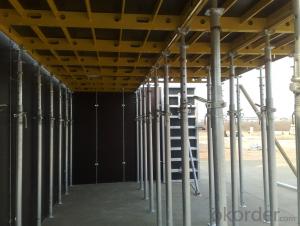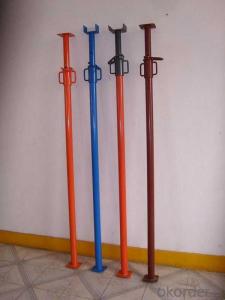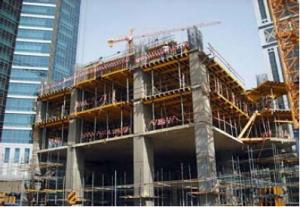cup lock scaffolding standard &cup lock scaffolding ledger OEM SERVICE, MANUFACTURER
- Loading Port:
- Tianjin
- Payment Terms:
- TT OR LC
- Min Order Qty:
- 10000 PCS
- Supply Capability:
- 10000 PCS/month
OKorder Service Pledge
OKorder Financial Service
You Might Also Like
Quick Details
| Size:: | 48.3*3.25mm | ||||
| Material:: | Steel (Q235/Q345) | Surface:: | Electro Galvanized/Self Color/Painted/HDG | Component:: | Standard, Ledger, Diagonal, Bracket, Top&Bottom cup, Ledger blade etc |
Packaging & Delivery
| Packaging Detail: | As the Requirment of Clients |
| Delivery Detail: | 20 days |
Specifications
1.OEM Service,EN74 & BS1139
2.competitive price,fast delivery,good service
3.more than ten-years' experience
4. Samples ok
Product Description
Cuplock Scaffolding System and Accessory for Construction Slab Formwork
It is a multi purpose system scaffold, suitable for access and formwork support in all types of construction of building & civil engineering projects. This complete galvanized system is probably the fastest and most-widely preferred scaffold system.
Material: Steel (Q235/Q345)
Size: 48.3*3.25mm
Surface: Electro Galvanized/Self Color/Painted/HDG
Component:
Standard, Ledger, Strengthened ledger, Transom Beam, Diagonal, Bracket, Top cup, Bottom cup, Ledger blade, etc.
Application:
Highways/Subways, Bridges, Tunnels and Fire Electrical Engineering, Marine Engineering
Advantage: Durable, Stable, Skid-proof, Antirust, Easy to assemble & Dismantle
OEM service is available
Custom-made service is available
- Q: What is the installation spacing of the steel support of the tunnel 50mm
- According to the specification, installation of +5, -5, but the general requirements not only go online, now some requirements to a total of zero error, that is in accordance with the design of steel arch control quantity, to the final detection according to the length calculation of steel arch number
- Q: Can steel props be used in the installation of temporary seating or bleachers?
- Yes, steel props can be used in the installation of temporary seating or bleachers. Steel props provide strong structural support and stability, making them suitable for temporary seating or bleacher installations. They can be easily adjusted to the required height and provide a secure foundation for the seating or bleacher structure.
- Q: What are the design considerations for using steel props?
- Several important factors must be taken into account when considering the use of steel props in a design. These factors include load capacity, adjustability, stability, safety, and ease of installation and removal. Load capacity is one of the primary design considerations for steel props. The props must have the ability to support the weight of the structure or load they are intended to support. This requires careful calculation and evaluation of expected load, considering variables such as structure type, materials used, and additional forces or stresses on the props. Another crucial consideration is adjustability. Steel props should be easily adjustable to accommodate different heights and provide flexibility during construction or renovation projects. The ability to extend or retract the props allows for precise positioning and support, ensuring stability and accuracy in the construction process. Stability is critical when using steel props, as they must provide a secure and stable support system. The design should incorporate features such as a wide base or additional bracing to prevent potential movement or collapse. This is especially important when the props are supporting heavy loads or are subject to external forces like wind or vibrations. Safety is a paramount consideration in any design involving steel props. The design should prioritize the safety of workers and others on the construction site by minimizing the risk of accidents or injuries. This may involve incorporating safety features like non-slip surfaces, secure locking mechanisms, or visual indicators to ensure proper installation and usage. Lastly, ease of installation and removal is an important consideration to facilitate efficient and cost-effective construction processes. The design should allow for quick and easy assembly and disassembly of the props, reducing labor and time requirements. This can be achieved through features like lightweight materials, user-friendly mechanisms, and intuitive instructions. In conclusion, when designing with steel props, it is crucial to consider factors such as load capacity, adjustability, stability, safety, and ease of installation and removal. By carefully addressing these considerations, engineers and designers can ensure the effective and safe use of steel props in construction projects.
- Q: Can steel props be used to support formwork?
- Yes, steel props can be used to support formwork. Steel props are adjustable telescopic devices that are commonly used to support formwork during construction. They are designed to provide vertical support and stability to the formwork structure, ensuring that it can safely hold the weight of the concrete being poured. Steel props are preferred for formwork support due to their strength, durability, and adjustability, allowing for easy installation and removal. They are also versatile and can be used in a variety of construction applications, including supporting slabs, beams, walls, and columns. Overall, steel props are an effective and reliable choice for supporting formwork during construction projects.
- Q: How do steel props compare to hydraulic shores in terms of safety?
- Steel props and hydraulic shores are both commonly used in construction to provide temporary support to structures. In terms of safety, both options have their advantages and considerations. Steel props are typically more rigid and can handle heavier loads, offering stability and reliability. However, they require manual adjustment and might not be as adaptable to uneven surfaces. On the other hand, hydraulic shores offer the advantage of adjustable height and easy installation, making them suitable for quick and efficient support. Nevertheless, their reliance on hydraulic pressure introduces the risk of leaks or sudden failure. Ultimately, the choice between steel props and hydraulic shores should be based on the specific project requirements and a thorough assessment of safety considerations.
- Q: Can steel props be used in residential tower construction?
- Yes, steel props can be used in residential tower construction. Steel props are commonly used as temporary supports during construction to provide stability and prevent collapse. They are versatile and can be adjusted to different heights, making them suitable for various construction projects, including residential tower construction.
- Q: Can steel props be used in the construction of temporary exhibition or trade show structures?
- Yes, steel props can certainly be used in the construction of temporary exhibition or trade show structures. Steel props are commonly used in construction to provide temporary support and stability. They are strong, durable, and able to withstand heavy loads, making them suitable for the construction of temporary structures. Additionally, steel props are adjustable, allowing for flexibility in creating custom designs and layouts for exhibition or trade show spaces.
- Q: Can steel props be used for temporary support in railway bridge construction?
- Yes, steel props can be used for temporary support in railway bridge construction. Steel props are commonly used in construction projects to provide temporary support and stability, and they can effectively withstand heavy loads and provide structural integrity during the construction process.
- Q: Can steel props be used for supporting temporary amusement park rides?
- Indeed, temporary amusement park rides can be supported by steel props. Within the realm of construction, steel props are often employed to provide stability and bear substantial loads. Their structural design enables them to endure immense weight and pressure, rendering them fitting for the purpose of supporting amusement park rides. Nevertheless, it remains imperative to ensure the correct installation and adherence to safety regulations concerning the steel props. These precautions are indispensable in guaranteeing the rides' stability and security.
- Q: Are steel props suitable for supporting temporary retail structures?
- Temporary retail structures can be effectively supported by steel props. These props, also referred to as adjustable steel props or acrow props, are extensively used in construction projects to offer temporary support to structures. Their adaptability and versatility, owing to their adjustable height feature, make them suitable for various sizes and heights of retail structures. Steel props possess robustness and durability, enabling them to handle heavy loads. Typically manufactured from high-quality steel, they guarantee stability and safety. Their adjustable nature facilitates effortless installation and removal, making them an excellent choice for temporary structures like pop-up retail shops or temporary market stalls. Additionally, steel props can be easily transported and assembled, a crucial aspect for swiftly setting up and dismantling temporary retail structures. They establish a dependable and secure support system, ensuring the stability and structural integrity of the retail setup. To sum up, steel props are an ideal choice for supporting temporary retail structures due to their strength, durability, adjustability, and ease of installation. They furnish a secure and stable support system, making them a reliable option for temporary retail arrangements.
Send your message to us
cup lock scaffolding standard &cup lock scaffolding ledger OEM SERVICE, MANUFACTURER
- Loading Port:
- Tianjin
- Payment Terms:
- TT OR LC
- Min Order Qty:
- 10000 PCS
- Supply Capability:
- 10000 PCS/month
OKorder Service Pledge
OKorder Financial Service
Similar products
Hot products
Hot Searches

